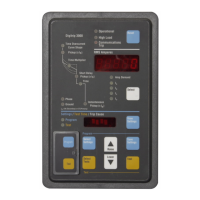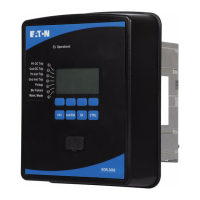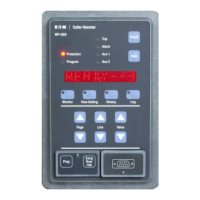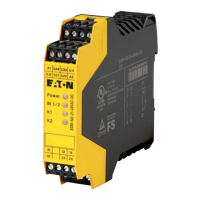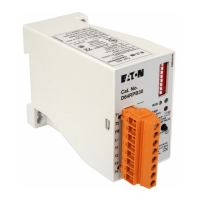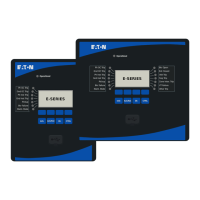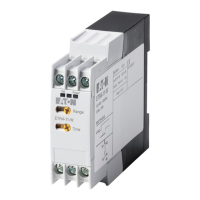Do you have a question about the Eaton Digitrip 3000 series and is the answer not in the manual?
General safety advice and warranty information for the Digitrip 3000.
Overview of the Digitrip 3000 as a panel-mounted, microprocessor-based overcurrent relay.
Details the primary function of overcurrent protection and available protective functions.
Lists relevant UL and other industry standards for the Digitrip 3000.
Covers RMS sensing, pickup settings, time settings, curve settings, integral testing, and comms.
Explains the true RMS sensing capability for accurate current measurement.
Defines pickup settings and lists current-based tripping functions.
Describes time settings for overcurrent protection and how timing functions reset.
Details flexibility in inverse time overcurrent curve shaping and selection.
Describes the accessible integral field testing capability for relay verification.
Covers the relay's communication capabilities via PowerNet Protocol.
Details the physical components of the protective relay hardware.
Describes the components of the front operations panel including pushbuttons, LEDs, and displays.
Explains the rear access panel, DIP switches, and terminal blocks.
Specifies external hardware requirements for the relay.
Introduces the operation section and refers to wiring diagrams.
Describes the power-up sequence and internal self-testing procedures.
Details the operations performed on the front panel controls.
Explains how curve shapes and settings affect the relay's characteristic curve.
Details the steps for entering and programming the Digitrip 3000 relay.
Provides a flowchart overview of the programming sequence.
Describes how to enter and perform tests in the Digitrip 3000's Test Mode.
Explains how the relay communicates with host computers.
Details how to configure the relay's communication address and baud rate.
Explains zone selective interlocking for improved fault clearing and coordination.
Introduces installation, wiring, startup, and testing details for the relay.
Describes how to prepare the panel for mounting the Digitrip 3000.
Provides dimensions and requirements for the panel cutout.
Details the procedure for mounting the protective relay onto the panel.
Guides on replacing a Digitrip MV with a Digitrip 3000, including DIP switch settings.
Provides guidance on wiring the Digitrip 3000 protective relay.
Outlines procedures for initial power application and startup.
Covers miscellaneous testing procedures, including dielectric testing precautions.
General information on maintenance and the intended service personnel.
Guidelines for storing the Digitrip 3000 Protective Relay.
A guide to identify and resolve common problems with the Digitrip 3000 relay.
Presents time-current curves for inverse time overcurrent protection.
Introduces Appendix A, focusing on the Drawout Case option for the Digitrip 3000.
Describes the DT3001 Drawout Relay and its specifications.
Provides installation guidance specifically for the Digitrip 3001 Drawout Relay.
Details panel preparation for mounting the Drawout Case.
Lists the included parts for the DT3001 Drawout Relay.
Guides on mounting the outer case of the Drawout Relay.
Discusses application considerations for zone selective interlocking.
Covers the operation of the drawout feature, including insertion and removal.
Details the procedure for inserting the Digitrip 3001 into its drawout enclosure.
Describes the procedure for safely removing the Digitrip 3001 from its drawout enclosure.
Introduces Appendix B, covering the Dual-Source Power Supply addition.
Describes the Digitrip 3000 with Dual-Source Power Supply (DSPS).
Explains the functional description of the DSPS and its operation.
Covers installation procedures for the Digitrip 3000 with DSPS.
Details panel preparation for mounting the Digitrip 3000 with DSPS.
Guides on mounting the Digitrip 3000 with DSPS.
Provides wiring and setup instructions for the Digitrip 3000 with DSPS.
Discusses application considerations for sensitivity and CT ratios.
Discusses application considerations for sensitivity and CT ratios.
Explains tripping behavior during facility energization or fault conditions.
Addresses CT saturation issues and their impact on relay performance.
Details testing procedures for the Dual-Source Power Supply.
Outlines an in-service test for the DSPS.
Describes a lab bench test procedure for the DSPS.
General safety advice and warranty information for the Digitrip 3000.
Overview of the Digitrip 3000 as a panel-mounted, microprocessor-based overcurrent relay.
Details the primary function of overcurrent protection and available protective functions.
Lists relevant UL and other industry standards for the Digitrip 3000.
Covers RMS sensing, pickup settings, time settings, curve settings, integral testing, and comms.
Explains the true RMS sensing capability for accurate current measurement.
Defines pickup settings and lists current-based tripping functions.
Describes time settings for overcurrent protection and how timing functions reset.
Details flexibility in inverse time overcurrent curve shaping and selection.
Describes the accessible integral field testing capability for relay verification.
Covers the relay's communication capabilities via PowerNet Protocol.
Details the physical components of the protective relay hardware.
Describes the components of the front operations panel including pushbuttons, LEDs, and displays.
Explains the rear access panel, DIP switches, and terminal blocks.
Specifies external hardware requirements for the relay.
Introduces the operation section and refers to wiring diagrams.
Describes the power-up sequence and internal self-testing procedures.
Details the operations performed on the front panel controls.
Explains how curve shapes and settings affect the relay's characteristic curve.
Details the steps for entering and programming the Digitrip 3000 relay.
Provides a flowchart overview of the programming sequence.
Describes how to enter and perform tests in the Digitrip 3000's Test Mode.
Explains how the relay communicates with host computers.
Details how to configure the relay's communication address and baud rate.
Explains zone selective interlocking for improved fault clearing and coordination.
Introduces installation, wiring, startup, and testing details for the relay.
Describes how to prepare the panel for mounting the Digitrip 3000.
Provides dimensions and requirements for the panel cutout.
Details the procedure for mounting the protective relay onto the panel.
Guides on replacing a Digitrip MV with a Digitrip 3000, including DIP switch settings.
Provides guidance on wiring the Digitrip 3000 protective relay.
Outlines procedures for initial power application and startup.
Covers miscellaneous testing procedures, including dielectric testing precautions.
General information on maintenance and the intended service personnel.
Guidelines for storing the Digitrip 3000 Protective Relay.
A guide to identify and resolve common problems with the Digitrip 3000 relay.
Presents time-current curves for inverse time overcurrent protection.
Introduces Appendix A, focusing on the Drawout Case option for the Digitrip 3000.
Describes the DT3001 Drawout Relay and its specifications.
Provides installation guidance specifically for the Digitrip 3001 Drawout Relay.
Details panel preparation for mounting the Drawout Case.
Lists the included parts for the DT3001 Drawout Relay.
Guides on mounting the outer case of the Drawout Relay.
Discusses application considerations for zone selective interlocking.
Covers the operation of the drawout feature, including insertion and removal.
Details the procedure for inserting the Digitrip 3001 into its drawout enclosure.
Describes the procedure for safely removing the Digitrip 3001 from its drawout enclosure.
Introduces Appendix B, covering the Dual-Source Power Supply addition.
Describes the Digitrip 3000 with Dual-Source Power Supply (DSPS).
Explains the functional description of the DSPS and its operation.
Covers installation procedures for the Digitrip 3000 with DSPS.
Details panel preparation for mounting the Digitrip 3000 with DSPS.
Guides on mounting the Digitrip 3000 with DSPS.
Provides wiring and setup instructions for the Digitrip 3000 with DSPS.
Discusses application considerations for sensitivity and CT ratios.
Discusses application considerations for sensitivity and CT ratios.
Explains tripping behavior during facility energization or fault conditions.
Addresses CT saturation issues and their impact on relay performance.
Details testing procedures for the Dual-Source Power Supply.
Outlines an in-service test for the DSPS.
Describes a lab bench test procedure for the DSPS.
